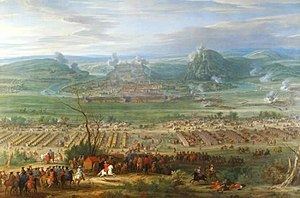Dates 19 Apr 1674 – 22 May 1674 | Result French victory | |
 | ||
Similar Siege of Groenlo, Siege of Cambrai, Battle of Entzheim, Battle of Sinsheim, Battle of Salzbach | ||
The Siege of Besançon was a military operation in Franche-Comté, then under Spanish rule, in 1674 as part of the Franco-Dutch War, aimed at annexing the province to the Kingdom of France. The siege ended with the conquest of the city by the French.
Contents
Context
The Franco-Dutch War, started in 1672, was mainly fought the first 2 years in the Dutch Republic. But a coalition was formed against the Kingdom of France in 1673, and when England decided not to support France anymore in February 1674, the French were forced to withdraw. In the spring of 1674, Louis XIV of France decided to attack the Franche-Comté, at the head of an army of about 70,000 men. While Louvois had planned to first take Salins-les-Bains and Dole before attacking Besançon, Vauban had intervened and advised the Minister to address the latter first, which was agreed upon.
During the Siege of Besancon, Etienne J. Morel (a French Army surgeon) used a tourniquet to control hemorrhage from battlefield injuries. This is the first reported use of a tourniquet.
Progress
Upon arrival at the site on April 26, Vauban decided to install 36 pieces of artillery on the Chaudanne hill overlooking the citadel from the west of the city. At night, on the backs of men and mules, the guns were carried upon the hill, and from that moment on, the city came under constant French fire. The city capitulated on May 15 and the citadel held out until it also capitulated on May 22.
